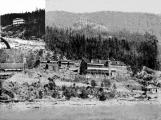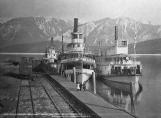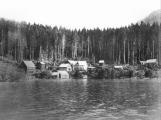1
A further trip north from Nakusp gave an opportunity to view an equally vibrant area of industrial growth. By way of forestry, mining, and modest agricultural activity, the Upper Arrow Lake was showing great promise with many towns emerging.
2
Upper Arrow Lake
UPPER ARROW LAKE

3
On the west shore between Pingston Creek and the towering Mount Odin, lies a massive flat mound of rock containing lead and zinc. Andy Symons registered a claim in 1897, but in spite of the narrow vein that was 12 to 14 miles (19 to23 km) in length, smelting would be difficult. Being of low grade, development of the ore body was questionable.
4
Big Ledge
UPPER ARROW LAKE

5
The hot springs at Halfway River across from Pingston Creek was known at this time. Evidence of a trail to the springs was seen but because the hot water was located almost two miles (3.22 km) from the lake, it left one to believe immediate development was not in the cards.
On nearing Halcyon Hot Springs, Captain Sanderson's original project of 1894, a most dramatic change had occurred. By incorporating the old structure into an addition and a new roof line, a large hotel resulted. Cabins were added along with a dance hall and recreation outbuilding. Indications were that the spa had now turned into a 'good-time' destination, although operating under the management of Dr. Brett, founder of the Banff Springs Sanitarium, its reputation was first class.
6
Halcyon Hot Springs
1898
Halcyon Hot Springs, BC

7
Sitting on the entrance to the Northeast Arm opposite Arrowhead, the DeCew sawmill was a notable addition to industry for the Upper Lake. Named the Arrowhead Saw and Planing Mill, it represented investment of eastern capital through the DeCew family from Ontario. Utilization of the virgin forests of the North Country was just in its most initial stage. At every mile that the Minto progressed, one could see the potential of the valley.
8
DECEW MILL
circa 1900
UPPER ARROW LAKE

9
Whatever the potential was, the CPR knew they were going to be part of any growth. Boats parked, like the Trail, Rossland and Minto at Arrowhead was a common site near the turn of the century. Passengers made up of miners, loggers, businessmen, and vacationers, along with tons of freight kept these boats and many tugs navigating the whole Arrow Lakes on daily runs.
10
CPR Sternwheelers
1898
Arrowhead, BC
 Credits:
Credits:
ALHS
11
Because Thomson's Landing was the gateway to the bustling Lardeau mining district, a side-trip up the Northeast Arm was a must. Surrounded by magnificent mountains, one immediately got a feeling of humbleness in relation to such an overpowering wilderness. After about nine miles (14.5 km) of calm green water, a clearing emerged enclosing a tiny settlement on the east shore. Of the crude structures spread over the small acreage, one building stood out. It was a hotel called the Prospector's Exchange; well named in light of the fact that many men heading for the hills, probably spent an hour or a day here before venturing off.
12
Beaton, BC
1897
Beaton, BC

13
Equally unsettled and surrounded by trees was a place called Comaplix. Directly across the arm from Thomson's Landing and although it had a name, there was little else present but a mill and some bunkhouses. Modified and expanded, the Kootenay Lumber Co. mill, one felt, could only succeed, given the huge tract of first-growth timber yet to be harvested from the Fish River Valley. This North Country looked destined to be the commercial centre of the Arrow Lakes. It was an exciting beginning to a pioneering era
14
Comaplix Mill
1898
UPPER ARROW LAKE







